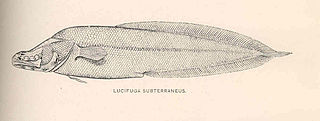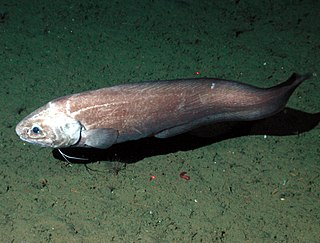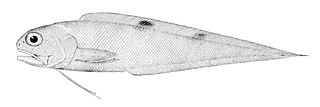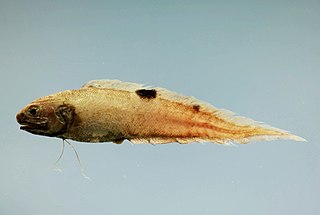Ophidiiformes is an order of ray-finned fish that includes the cusk-eels, pearlfishes, viviparous brotulas, and others. Members of this order have small heads and long slender bodies. They have either smooth scales or no scales, a long dorsal fin and an anal fin that typically runs into the caudal fin. They mostly come from the tropics and subtropics, and live in both freshwater and marine habitats, including abyssal depths. They have adopted a range of feeding methods and lifestyles, including parasitism. The majority are egg-laying, but some are viviparous.

The cusk-eel family, Ophidiidae, is a group of marine bony fishes in the Ophidiiformes order. The scientific name is from the Greek ophis meaning "snake", and refers to their eel-like appearance. True eels diverged from other ray-finned fish during the Jurassic, while cusk-eels are part of the Percomorpha clade, along with tuna, perch, seahorses and others.

Lucifuga is a genus of viviparous brotulas. Most of the species are native to caves and sinkholes in Cuba and the Bahamas; L. inopinata from deep water off the Galápagos Islands is the only exception. The four species rated by the IUCN are all considered vulnerable. The largest species in the genus reaches about 15 cm (5.9 in) in length.

Spectrunculus grandis is a species of Rhizopharyngia ray-finned fish in the cusk-eel family known by the common names pudgy cusk-eel and giant cusk-eel. It is one of two species in the formerly monotypic genus Spectrunculus, the other species, S. crassus, having been differentiated in 2008.
Brotulotaenia is a genus of cusk-eels. It is the only genus in the subfamily Brotulotaeniinae.

Genypterus is a genus of cusk-eels.
Glyptophidium is a genus of cusk-eels.
Hoplobrotula is a genus of cusk-eels.
Lamprogrammus is a genus of cusk-eels.

Lepophidium is a genus of cusk-eels.
Luciobrotula is a genus of cusk-eels. The larvae have an ovoid body, elongate anterior dorsal-fin ray, and long trailing fleshy filament

Neobythites is a genus of cusk-eels.

Ophidion is a genus of cusk-eels.

Otophidium is a genus of cusk-eels, part of the subfamily Ophidiinae in the family Ophidiidae. They are found in the western Atlantic and eastern Pacific.
Parophidion is a genus of cusk-eels found in the Atlantic Ocean and the Mediterranean Sea.
Porogadus is a genus of cusk-eels.

Pycnocraspedum is a genus of cusk-eels.
The gargoyle cusk is a species of cusk-eel from the subfamily Neobythitinae of the family Ophidiidae. This species grows to a length of 57 centimetres (22 in) TL. It is the only known member of its genus, although research suggests the species should be classified in the genus Acanthonus.

Neobythitinae is a subfamily of cusk eel from the family Ophidiidae. They are mostly fishes of deeper waters, occurring from the continental shelf down to as deep as 8,370 metres (27,460 ft) at the bottom of the Puerto Rico trench where the deepest known fish, Abyssobrotula galatheae, has been taken.
Spectrunculus crassus is a species of cusk-eel native to the Atlantic and eastern Pacific.










